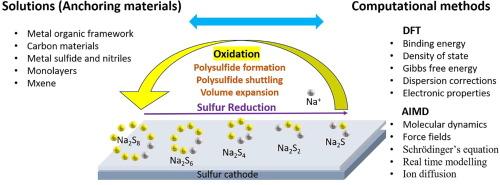A theory perspective of the polysulfide absorbing materials for room-temperature sodium-sulfur batteries
IF 14.9
1区 化学
Q1 Energy
引用次数: 0
Abstract
Though the formation of polysulfide is desirable, as it contributes to the capacity build-up, it must not leak into the electrolyte. The loss of polysulfide causes capacity fade, a change in the local chemistry of the electrolyte, and anode poisoning. Constant efforts are in progress to find suitable polysulfide-absorbing materials; however, the magical polysulfide absorber is yet to be discovered or developed. Experimental methods alone often fall short in accelerating the investigations may be due to the complex Nature of the testing. This review focuses on the importance of computational methods, particularly density functional theory (DFT), in screening suitable polysulfide absorbers. It highlights the critical role of anchoring materials in improving Na-S battery performance, including pristine and doped graphene, metal–organic frameworks, carbon Nanofibers, vanadium disulfide, MXenes, and metal sulfides. By examining adsorption energies, charge transfer mechanisms, and catalytic properties, this review provides insights into the design of advanced materials that can effectively immobilize polysulfides and enhance battery stability. The review aims to guide future research efforts toward the development of high-performance RT Na-S batteries through a comprehensive understanding of the polysulfide-absorbing materials.

室温钠硫电池用多硫吸收材料的理论展望
虽然多硫化物的形成是可取的,因为它有助于容量的积累,但它不能泄漏到电解质中。多硫化物的损失导致容量衰减,电解质局部化学性质的变化,以及阳极中毒。人们正在不断努力寻找合适的多硫化物吸收材料;然而,神奇的聚硫吸收剂尚未被发现或开发。实验方法本身往往不足以加速调查,这可能是由于测试的复杂性。本文综述了计算方法,特别是密度泛函理论(DFT)在筛选合适的多硫吸收剂中的重要性。它强调了锚定材料在提高Na-S电池性能方面的关键作用,包括原始和掺杂石墨烯、金属有机框架、纳米碳纤维、二硫化钒、MXenes和金属硫化物。通过研究吸附能、电荷转移机制和催化性能,本综述为有效固定多硫化物和提高电池稳定性的先进材料的设计提供了见解。综述旨在通过对多硫化物吸收材料的全面了解,指导未来研究工作朝着高性能RT Na-S电池的方向发展。
本文章由计算机程序翻译,如有差异,请以英文原文为准。
求助全文
约1分钟内获得全文
求助全文
来源期刊

Journal of Energy Chemistry
CHEMISTRY, APPLIED-CHEMISTRY, PHYSICAL
CiteScore
19.10
自引率
8.40%
发文量
3631
审稿时长
15 days
期刊介绍:
The Journal of Energy Chemistry, the official publication of Science Press and the Dalian Institute of Chemical Physics, Chinese Academy of Sciences, serves as a platform for reporting creative research and innovative applications in energy chemistry. It mainly reports on creative researches and innovative applications of chemical conversions of fossil energy, carbon dioxide, electrochemical energy and hydrogen energy, as well as the conversions of biomass and solar energy related with chemical issues to promote academic exchanges in the field of energy chemistry and to accelerate the exploration, research and development of energy science and technologies.
This journal focuses on original research papers covering various topics within energy chemistry worldwide, including:
Optimized utilization of fossil energy
Hydrogen energy
Conversion and storage of electrochemical energy
Capture, storage, and chemical conversion of carbon dioxide
Materials and nanotechnologies for energy conversion and storage
Chemistry in biomass conversion
Chemistry in the utilization of solar energy
 求助内容:
求助内容: 应助结果提醒方式:
应助结果提醒方式:


